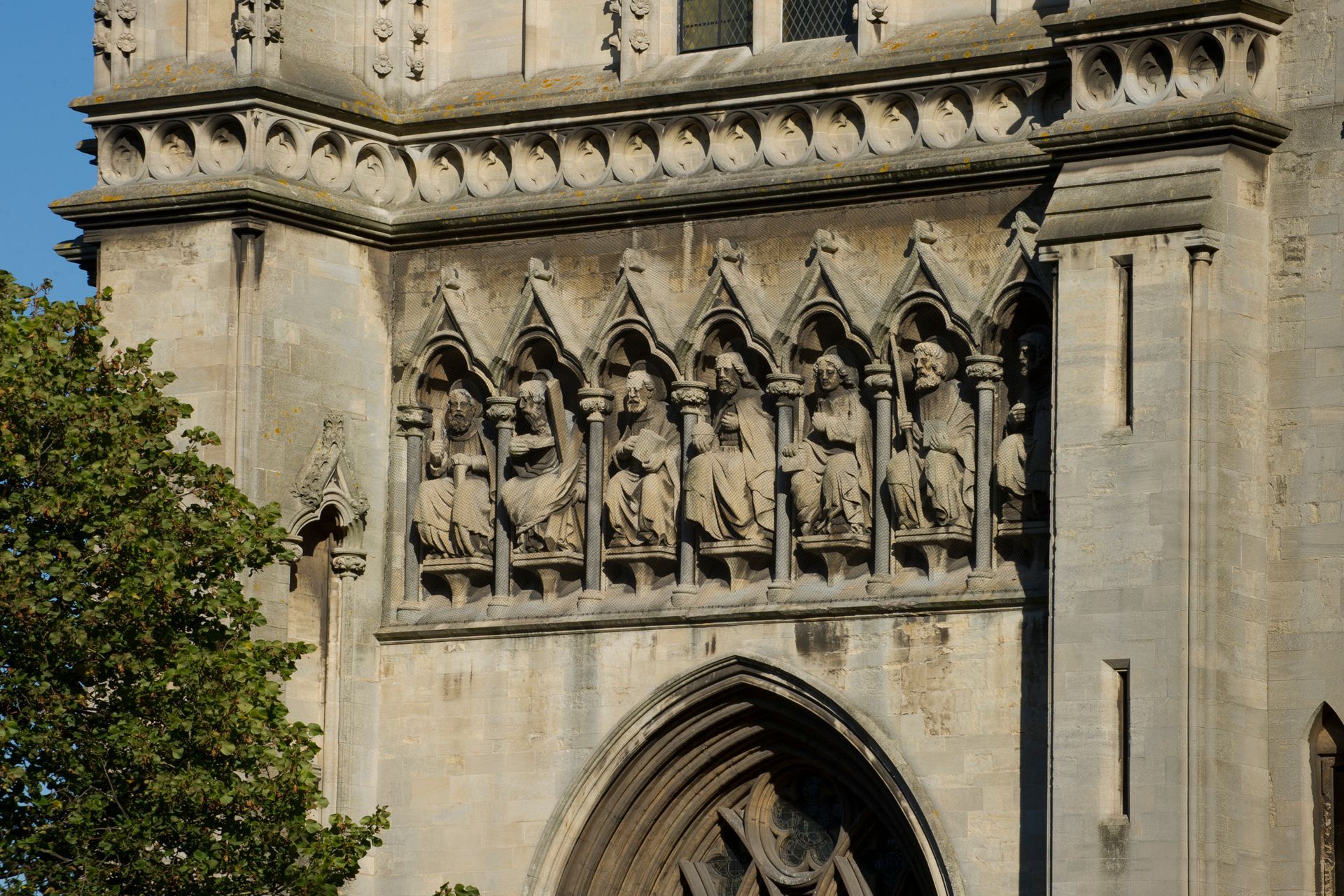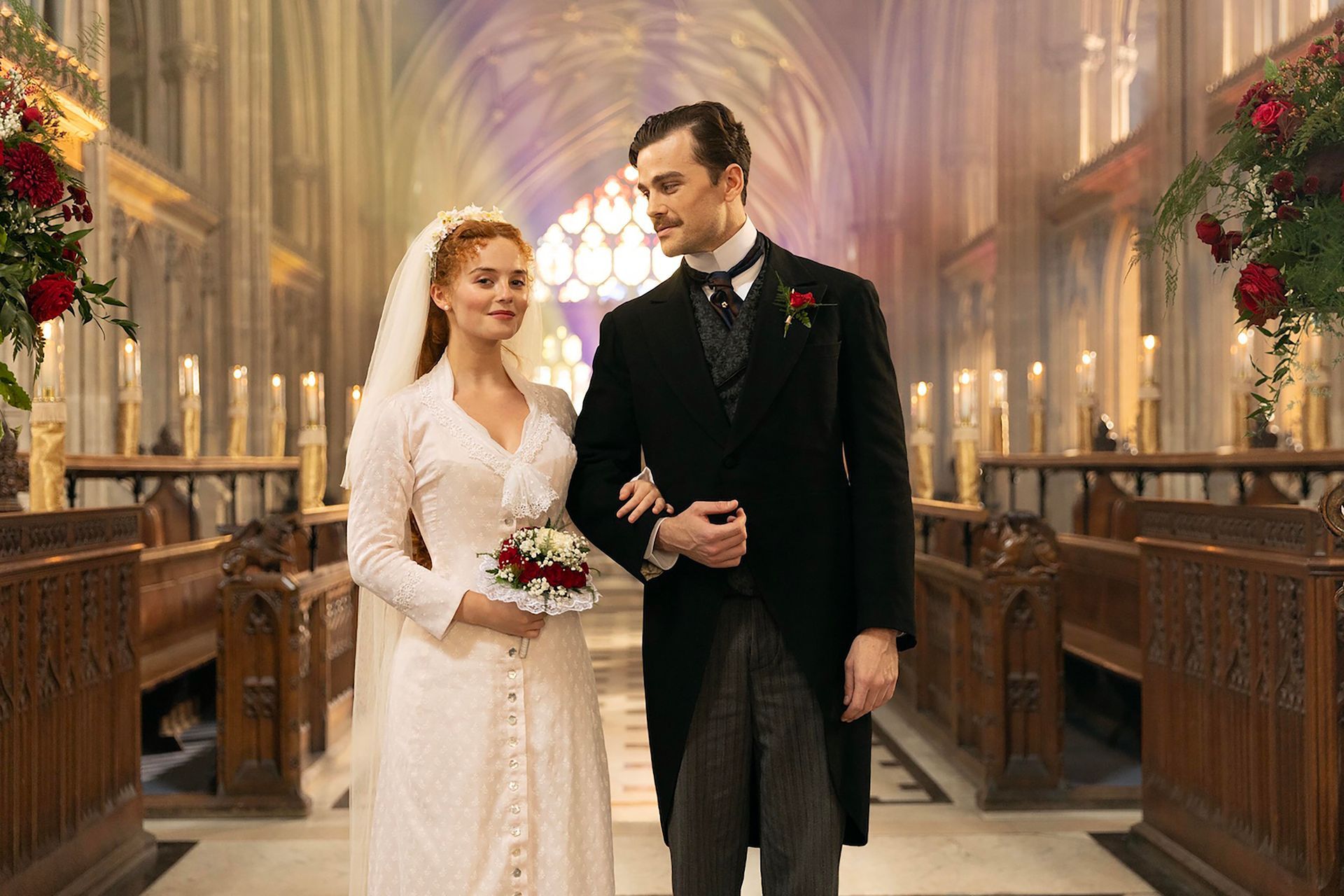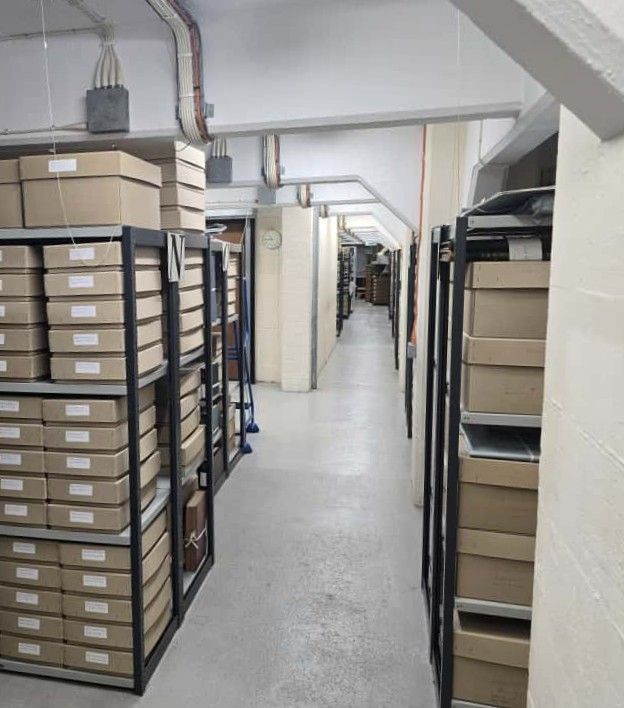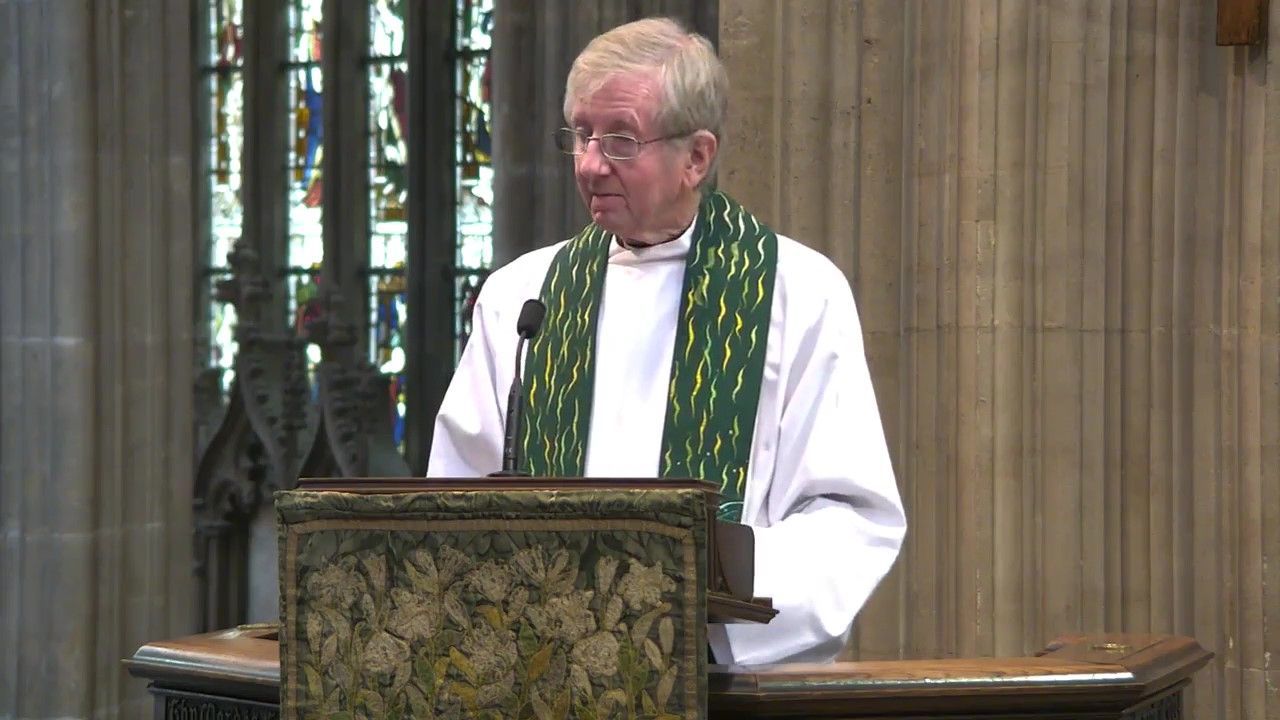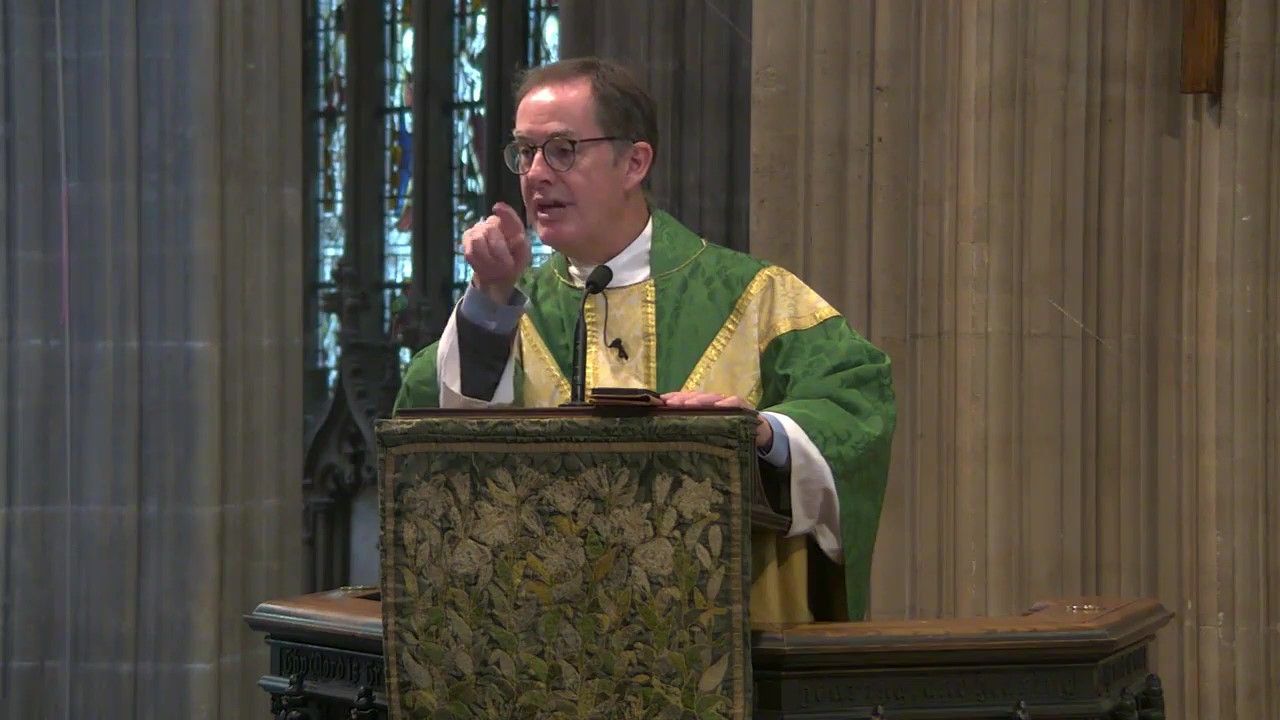St Mary Redcliffe West Nave Window
During 2025, important restoration work will be carried out on St Mary Redcliffe's magnificent West Nave window. You can read about the history of the window and its place in the great Victorian restoration of the church below.
St Mary Redcliffe Church: West Window
Introduction
The West Window at St Mary Redcliffe is a large and significant feature of the church that has for 150 years in its current form helped to define and beautify the interior of the Nave. Its renovation and installation in 1868 during the final stages of the great C19th restoration of the church, was part of a series of works that erased the last vestiges of the C18th Baroque interior and established a condition, consistent with a Victorian conception of the medieval gothic church, that has broadly persisted to the present day.
Subject
The subject of the West Window is the Annunciation, showing Christ in Majesty above a crowned Mary depicted as the Queen of Heaven. There are ten main lights with trefoil heads and seventeen tracery elements with associated eyelets. The traceries depict scenes from the life of the Virgin, featuring female saints and kings.1 It is one of two windows in the church designed by the firm Hardman & Co. – the other, depicting the Ascension, was installed in the North Choir Aisle in 1872.
Background: The C19th Restoration
The major Victorian restoration of St Mary Redcliffe began in 1842, following the removal - under the auspices of the Bristol Improvement Act - of the buildings that once stood to the north of the church and constituted the fragmented remnants of the medieval mansion house and estate that had once belonged to the Prebendary of Salisbury. On the removal of these buildings, the “precarious condition of thew whole edifice was exposed” and the “urgent necessity of doing something on a large scale for the preservation of the church”2 realised by parish authorities, who saw in the dilapidated condition of the fabric both a major challenge and an exciting opportunity.
During these early days of the restoration, the church’s Restoration Committee decided that the grand project should be attempted in stages, with the first effort focusing on the tower and spire; that the need for remedial works to ensure the survival of the structure should go hand in hand with work to reinstate lost or degraded decorative elements; and that the restoration of the structure and external elements afforded an opportunity for the restoration and representation of the church interior, including the “reinstatement of the east and clerestory window” and the removal of “inappropriate attachments”,3 with particular reference to three panels of William Hogarth’s altarpiece.
By 1847, despite having run out of funds, the Restoration Committee’s ambitions for the reinstatement of stained glass had broadened. Its members became, “desirous to avail themselves of the great improvements which have recently been made in the art of staining glass, and thus to restore within the fabric that gloriously warm colour and tone of which we see faint evidences in the shattered fragments remaining in the casements.”4
Perhaps because of the early difficulties in procuring funds for the restoration, the committee also encouraged, even demanded, the munificence of wealthy individuals in supporting the restoration of the interior, including the reinstatement of stained glass in the church. Referring to the need for funding to realise the proposed scheme to fill the eastern window with stained glass designed by William Wailes, the Restoration Committee,
hoped indeed that some wealthy and well-disposed person will not hesitate to answer the invitation. Formerly these things were done by individuals…of late years many (stained glass windows) have been put up elsewhere and thus ornamental adjuncts of the fabric have been records of devotion and love. This committee, availing themselves of the revival of this practice, offer to any person who may desire to restore a specific portion – a window, or a buttress, say – to point out such as part as would cost a given sum. Thus, in the case of the east window, a noble opportunity is offered to anyone to particularise his donation. We do not wish to point out or prescribe, but we may suggest that there are many about the neighbourhood whose wealth would enable them to do this and more.5
This recognition of the need for additional private money to support the restoration of the church, and the invitation to the wealthy of Bristol to take part by ‘particularising’ or adopting specific projects within the wider programme of works, laid the groundwork for the subsequent significant involvement of individuals, families and societies in restoring parts of the church interior, including those elements at the west end of the church that had been identified as requiring attention.
The Restoration of the West End
It is interesting to note that even in 1842, the restoration of the tower and spire - expressed by the authors of the restoration proposal, Britton and Hosking, as being of primary importance - was conceived as including the re-presentation of the interior west end of the church, which included remedial measures relating to the C18th organ and the infilling of the West Window with stained glass:
In the restoration of the Spire will be involved some alterations, pointed out by them (Britton and Hosking), at the west end of the church, including a new arrangement for the organ; and they express their hope, that as the whole of the lead and glass must be removed from the windows for the restoration of the mullions and tracery, it may, in the principal ones at least, be reinstated with stained glass of an appropriate character.6
The restoration of stained glass at the west end of the church was, then, among the founding principles of the C19th restoration that had been identified as a key ambition in 1842, receiving public expression in the published restoration appeal.
From Baroque to the Gothic
The appeal also refers to a feature and condition that had existed at the west end of the nave since 1726 when the area in front of the West Window was filled by one of the most significant Georgian introductions to the church – the Harris and Byfield organ – “one of the largest English Organs of its day”.7 This nationally significant instrument was mounted on a grand classically screened gallery designed by the architect John Strachan. The replacement of this ‘Corinthian’ screen with one of gothic design in 1840-41 was considered by the vestry the “first step in restoring the church to its original architectural unity”.8 Together, the organ and screen stood fifty-three feet in height, filling the width and height of the west Nave. Contemporary illustrations of the organ9 clearly show its scale and its effect of entirely obscuring the West Window.
At a meeting of the Restoration Committee in 1857, Sholto Vere Hare made a conditional offer to replace the glass in the window:
Mr Sholto Hare kindly intimated, that if the restoration of the West Window could be accomplished, and the Organ was removed so that the window would be open to the Nave, he would present stained glass to fill it, of a design to be approved by the Committee. The architect was subsequently instructed to prepare plans for the restoration of that portion of the Church, but the state of the funds forbids the Committee from projecting any operations in this direction for the present, and they are obliged to content themselves with the hope of such continuous aid from the public as will ultimately place them in a position to accept Mr. Hare's liberal offer.10
By the 1860s, frustration had been growing that the ‘new arrangement’ for the organ had yet to be realised. Hare’s offer, being predicated on the removal of the organ, served to exacerbate a general sense of impatience at the slow rate of progress. The following statement from the newly appointed vicar, Randall, makes clear the interconnectedness of the organ’s removal and renovation of the West Window:
Some few years ago Mr Sholto V. Hare expressed a desire to put a stained-glass window in the west end – stipulating, however, that the stonework should be renovated, and the organ removed. The former of these stipulations has been complied with and the latter will be in a short time, so that we may soon hope to see a beautiful window at the west as well as at the east end of the church.11
Hare’s insistence on the introduction of new stained glass being contingent on the removal of the organ adds to the significance of the West Window in supporting an understanding of the Victorian reimagining of the church: its restoration was predicated on the destruction of one of the celebrated features of the Baroque interior. The process of restoring the west end of the church, can be seen to realise the twin principles of removal and renovation that informed the broader restoration, the former motivated by a determination to remove evidence of C18th ‘inappropriateness’, as expressed in 1842 by the Vicar, Churchwardens and Vestry.
The move from a Baroque to a renewed ‘Gothic’ church, had a transformational impact on the church interior. The major modifications at the east and west ends of the church, that bookended the restoration of the interior both physically and chronologically, would have had a significant impact on the experience of light and space in the church. Prior to its reconfiguration in the 1840s and 50s, which included the removal of a classically styled wooden altar screen, the unblocking and uncovering of the east window, and the removal of the three panels of Hogarth’s altarpiece, the east end of the church would have been a much darker area than it is today. Similarly, the huge organ at the west end would have blocked most of the light from the West Window.
The combined impact of the actions at the west end of the church can be appreciated by an 1868 report from Daily Bristol Times and Mirror, which also makes clear that Hare’s rejuvenated West Window was, initially at least, received favourably:
The interior of the west end of the nave has been renewed and thrown open. The old organ case has been removed from the west end, and the wood and stone screens taken away, this portion of the church being now completely open. The splendid memorial window erected by Mr. Sholto V. Hare to the memory of his father and mother has been completed at very considerable cost, and this has added largely to the beautiful and imposing appearance at this end of the building.12
Sholto Vere Hare
Sholto Vere Hare was a significant figure, both in the context of St Mary Redcliffe and its restoration, and in the wider context of Bristol civic life. Scion of a “notable firm of floor cloth manufacturers”,13 he was Churchwarden of St Mary Redcliffe in the 1850s, Mayor of Bristol in 1862, president of the St Mary Redcliffe founded Colston Parent Society in 1863, Master of the Society of Merchant Venturers in 1866-67, and three-times unsuccessful Conservative candidate for the Parliamentary representation of the city.
In 1845, Hare was present at the opening of Admiral William Penn’s tomb, during which event he made a sketch of Penn’s body.14 In 1852, while Churchwarden, he had instigated the investigations that led to the discovery of stellate recesses in the south aisle, which in turn led to the removal of the effigies of William Canynges and his wife Joan to that part of the church.15 He played an important role in the church’s commemoration of the poet Chatterton - perhaps the primary cause of the church’s widespread C19th fame - by paying for the reinstatement of Chatterton’s statue in the north churchyard and arranging the memorial stone to Chatterton’s family which can still be seen in the south churchyard.16 In 1874 he became the last C19th President of The Canynges Society before its dissolution at the end of the thirty-year process of restoration.17 Hare’s obituary, following his death in 1900, made clear his long-standing involvement with the church and its restoration:
He, as a Redcliff man, took a deep interest in Redcliffe church and an active part in its restoration. He gave the beautiful window at the west end of the structure in memory of his mother. He also erected at his own cost the monument to the boy poet Chatterton, a statue still standing in the north-east corner of the churchyard.18
The Commission of New Stained Glass for the West Window.
It is worth quoting in full the section on the West Window from Peter G. Cobb’s essay The Stained Glass of St. Mary Redcliffe,19 produced under the auspices Bristol & Gloucestershire Archaeological Society, in which Cobb provides a detailed summary of the process, largely driven by Hare, of commissioning new stained glass for the West Window, including his engagement of Pugin’s student and son-in-law John Hardman Powell to deliver an appropriate design. The essay highlights the significance of Hare’s choice of subject - the Annunciation – which was related to the church’s dedication – details the seemingly tortuous negotiations between sponsor and designer, and provides insight into the determined character of Hare and the prominent role played by powerful, wealthy and ambitious individuals in propelling important parts of the church’s restoration.
As early as 1857 Sholto Vere Hare, a manufacturer of patent floorcloth, had intimated that, if the restoration of the west window could be accomplished and the organ moved so that the window could be open to the nave, he would present the Committee with the stained glass for it. In spite of Canon Madan's efforts, even a fierce threat to have nothing more to do with the restoration if something were not done, the organ was still blocking the west window at the end of his incumbency in 1865. Efforts were made to persuade Sholto Hare to put up a window in the North transept where the Handel Window was originally destined, but he refused to change his plans. In 1866 he renewed his efforts to glaze the west window and the energetic new vicar soon had the organ dismantled and reported that the gallery would be moved 'as soon as Mr Sholto Hare's stained glass window is ready to be put in. Sholto Hare had a mind of his own. He wanted his window to be 'of the richest and most costly kind. 'The glass and colouring must be of the richest and very best, the drawing accurate and the figures well defined, so that the window may be worthy of the most beautiful Parish Church in the West of England. He suggested to the Committee that the subject of the window should be the Annunciation. He explained his reasons more fully to John Hardman Powell who eventually designed it: 'The Church being dedicated to the Virgin Mary, and none of the painted windows already therein exclusively or mainly illustrating her sacred history, it seems to me that this would be a good opportunity of supplying the defect, and if the space to be filled would accord well with prominent features of the New Testament as connected with the Virgin, I should prefer it. However, he did consult the Committee about a suitable firm to design and make the window. They suggested either Clayton & Bell or Lavers & Barraud as being highly spoken of. Hare was not convinced, and a month later was still seeking more information. He seems to have applied to John Hardman & Co. of Birmingham on his own initiative. John Hardman, who lived in Clifton in the last years of his life, had been persuaded by A.W.N. Pugin, the great Gothic Revivalist, to start making stained glass to his design in 1845. The firm produced some very fine glass throughout the century, even after Pugin's death in 1852 when J.H. Powell, his nephew, became chief designer. Hare was very critical of the design which Powell sent him and ordered various alterations. Even then he was not satisfied and became very frustrated: 'I wish it were in my power to draw what I want, a rich beautiful Chorale, charming the Eye and leading it to the Saviour in the centre. The Chorale to be rich with deep tints of purple, ruby and gold, and its circular form well defined. Eventually he was satisfied: he told Powell that he hoped it would be his 'Bristol monument for all generations.' The cartoons were ready for the Restoration Committee's meeting in January 1868, and the window was in for the Canynges Society annual meeting. The cost was £375 for the glass, £20 for the wire guards and £15 for the fitting. Apparently, it did not meet with universal approval. The Vicar reported at a later meeting of the Restoration Committee that 'Messrs. Hardman had sent down and removed several objectionable parts of the West Window and considerably improved it. We can only speculate what was removed as there seems to be no record in the Hardman archive. What is surprising is that the crowned figure of the Virgin Mary survived. The window is not to everyone's taste: a recent writer described it as 'sentimental, theatrical and somehow unAnglican' - but it is nevertheless a fine example of the work of Hardman's studio.19
Contemporary reactions
Contemporary reactions to the new West Window seem to have been broadly positive. On June 6 1868, the Saturday Bristol Times and Mirror reported that,
The splendid old building never looked better than it did on Sunday. During the past week, the new memorial window presented by Sholto Vere Hare has been put in at the west end. We have before described the subjects of the illustrations, but we may add that it is a magnificent work of art by Messrs. Hardman of Birmingham.20
In October 1868, in a detailed report on the restoration at St Mary Redcliffe, The Daily Bristol Times and Mirror included the following note:
The splendid memorial window erected by Mr Sholto Vere Hare to the memory of his father and mother has been completed at very considerable cost. And this has added largely to the beautiful and imposing appearance at this end of the building.21
In December 1869, while reading a paper entitled Painted and Stained Glass, the Rev R. W. Hautenville of Weston-in-Gordano noted of St Mary Redcliffe Redcliffe that, “A very good window by Hardman had lately been placed at the west end of the Nave.”22
The Bristol librarian, J.F. Nicholls, in his guidebook, How to See Bristol: A Guide for the Excursionist, The Naturalist, The Archaeologist, and the Man of Business (1874) commented that:
The modern memorial windows are very fine, and from their number and the variety of the artists employed they form a veritable school for the study of this branch of ecclesiastical decoration…The last, and in more senses than one far from the least, of these charming adjuncts to the sacred edifice is the great west window, by Hardman: it was given by Mr. Sholto Vere Hare, for many years one of the churchwardens of the parish.23
John Hardman & Co. and A. W. N. Pugin
The aesthetic and religious qualities that were embedded in the window and which inspired the praise of visitors to the church, reflected the experience and skill of the Birmingham-based firm - John Hardman & Co. - that had been commissioned to produce the stained glass. Hardman & Co. was strongly associated with A. W. N. Pugin and the aesthetic and religious principles of the Gothic Revival. The firm’s founder, John Hardman (1766–1844) had produced metalwork designed by Pugin during the 1830s. In 1845, Hardman’s son - another John Hardman (1812–67) - began producing stained glass at Pugin’s request, working alongside Pugin and Hardman’s nephew, John Hardman Powell (1827–95) - the designer of St Mary Redcliffe’s West Window - who had been trained by Pugin as a young man.
Pugin - who acted as chief designer at Hardman & Co. until 1849 - played a pioneering role in the style of the Gothic Revival, developing, “a vision of Gothic architecture that was both romantic and deeply religious.”24 This pioneering sensibility, rooted in medievalism and the principles of medieval Gothic architecture, and imbued with a Catholic sensibility, also informed the stained glass designed by Hardman, Pugin and Powell. In The Stained Glass of John Hardman and Company under the leadership of John Hardman Powell from 1867 to 1895 (2007), Mathé Shepheard states that:
Before stained glass manufacture was capable of meeting the demands of the Gothic Revival and the renewed religious fervour, the craft had to be relearnt, for the legacy of the Reformation and the systematic iconoclasm that followed, with only a few pockets of resistance, had very nearly annihilated the art of stained glass… Pugin’s contribution to the revival of medieval forms of stained glass had been considerable, his difficulties and successes shared with Powell.25
Pugin and St Mary Redcliffe
Although St Mary Redcliffe’s commission of stained glass from Hardman & Co. took place more than a decade after Pugin’s death, he was certainly aware of the church during his lifetime. In his early work, Contrasts: A parallel between the noble edifices of the middle ages, and corresponding buildings of the present day (1836),26 he had chosen St Mary Redcliffe as an exemplar of medieval parochial church building, contrasting it favourably with the C19th All Souls Church in Langham Place, which had been designed by John Nash.
Later, in an 1840 letter referring to St Chad’s Cathedral, which he had designed, Pugin writes, “the great lay contributor to this building is Mr. J. Hardman, a man of Birmingham whom I may truly compare to the pious and munificent Cannyng (sic) of Redcliffe.”27
It is interesting to think that St Mary Redcliffe may have helped to inspire Pugin’s love of Gothic architecture and medieval craftsmanship, and inform the aesthetic principles that that later found expression in the Pugin-inspired stained glass of John Hardman Powell at the church.
John Hardman Powell
By learning directly from, and later working alongside Pugin, Powell had become a significant figure in the renewal of stained glass art and manufacture in England. In his youth he had lived and studied with his mentor, executing several of Pugin's designs for stained glass and metalwork. In 1849, he succeeded Pugin as the firm’s chief designer and in 1850 married Pugin’s daughter, Ann. Following Pugin's death in 1852, Powell returned to Birmingham and succeeded him in the position of artistic director of John Hardman & Company. Of Powell’s tenure, Shepheard writes:
He was talented and deeply religious, a Roman Catholic like Pugin and his fellow partners in Hardman. Correspondence indicates a personal relationship with Cardinal Newman, some traces of whose influence can be seen in the scriptural interpretations in the glass. Powell travelled in Europe to study stained glass and other sacred art. His work shows a fine discrimination between Anglican and Catholic doctrinal and spiritual positions, the windows designed under his leadership carefully respecting them. Under him the firm enjoyed numerous commissions, with most leading architects including Scott, Street and Woodyer.
By examining the firm’s output, it becomes evident that the windows were individually designed with no repeats, that the knowledge of scripture and use of Christian symbolism allowed the glass to project deeply spiritual messages and that it was aesthetically pleasing to clients who often expressed their appreciation in handsome terms.
There has been much twentieth century criticism of Hardman glass, but Powell was a highly trained and competent artist. After training at Pugin’s studio, the background of study, his own sensitivity, and continental visits equipped him to take the leading role in this enterprise and to give it continuity after the death of Pugin.28
By the time of the St Mary Redcliffe commission, Hardman & Co, under Powell’s leadership, were respected as one of the leading producers of stained glass in England.
Writer and theologian Patrick Comerford summarises Powell’s output thus:
Powell’s designs are original innovations in the Gothic style. His stained glass recreates the elegance, the refinement, the brevity that is seen in some of the finest examples of glass, sculpture and illumination of the 13th and 14th centuries. He utilises the flowing, curving lines, the flourish of drapery, the calligraphic brush-strokes and pure colour.29
Conclusion: The significance of the West Window
In 2018, the authors of a report on the stained glass at St Mary Redcliffe described the West Window as follows:
A fine quality window by Hardman depicting scenes from the life of the Virgin with Christ in Majesty…This splendid window is beautifully drawn and used the highest quality cylinder glass with pleasing variation in colour depth between each piece.30
The window is intrinsically significant because of its aesthetic qualities and its effect of beautifying the interior of the church. It is rich in religious significance, depicting scenes from the life of the Virgin Mary to whom the church is dedicated.
The window is also significant in helping to tell the story of St Mary Redcliffe, because knowledge of its pre-history, commission and reception, as well as its place in the C19th restoration, enhances our understanding of one of the great periods of development in the 800 year history of the church.
Lastly, the window is representative of perhaps the major cultural movement in C19th century England, constituting a fine example of the work of John Hardman Powell, one of the most skilful and celebrated stained glass designers of his age, and acting as a testament to the greatest exponent of the Gothic Revival movement, A. W. N. Pugin.
Rhys Williams - St Mary Redcliffe Heritage Development Manager
References
1 St Mary Redcliffe Stained Glass Condition Report/Conservation Proposal, Holywell Glass, 2018
2 Sixteen Years Doings in the Restoration of Redcliffe Church, St Mary Redcliffe Restoration Committee, 1858
4 Report on an address made by the St Mary Redcliffe Restoration Committee, The Bristol Mercury and Western Counties Advertiser, Saturday 4 December, 1847
5 Report on an address made by the St Mary Redcliffe Restoration Committee, The Bristol Mercury and Western Counties Advertiser, Saturday 4 December, 1847
6 Restoration of the Church of Saint Mary, Redcliffe, Bristol: an appeal by the vicar, churchwardens, and vestry; with an abstract of reports by Messrs. Britton and Hosking and engraved plan and views of the church, Rev. M. R.Whish et al., 1842.
7 St Mary Redcliffe, Bristol, Harrison and Harrison, 2020. Accessed at https://www.harrisonorgans.com/wp-content/uploads/2021/03/StMary-Redcliffe-Full-spec-2020.pdf
8 Report on a meeting of the Committee of the Architectural Society, Bristol Times and Mirror, Saturday 14 May, 1842
9 The Gothic Organ Screen, St Mary Redcliffe Church (print)
https://collections.bristolmuseums.org.uk/collections/ce698f94-c750-3933-830d-36cf930fce30/
10 Sixteen Years Doings in the Restoration of Redcliffe Church, St Mary Redcliffe Restoration Committee, 1858
11 Report on the work of The Canynges Society, The Western Daily Press, Monday 19 November, 1866
12 Report on the Restoration of St Mary Redcliffe, Daily Bristol Times and Mirror, Tuesday 20 October, 1868
13 Sholto Very Hare Obituary, Bristol Mercury, Friday 23 March, 1900
14 The Gentleman's Magazine Volume CCLXXXII, January-June 1897
15 THE Gentleman's Magazine Volume CCLXXXII, January-June 1897
16 How to See Bristol: A Guide for the Excursionist, The Naturalist, The Archaeologist, and the Man of Business, J.F. Nicholls, 1874
17 List of past presidents of The Canynges Society: https://canynges.co.uk/about-the-society/
18 Sholto Very Hare Obituary, Bristol Mercury, Friday 23 March, 1900
19 The Stained Glass of St Mary Redcliffe from Transactions of the. Bristol & Gloucestershire Archaeological Society CXII, Peter G. Cobb, 1994
20 The Mayor and Corporation at Redcliff Church, Saturday Bristol Times and Mirror, June 6, 1868
21 Report on the Restoration of St Mary Redcliffe, Daily Bristol Times and Mirror, Tuesday 20 October, 1868
22 Painted and Stained Glass, Bristol Times and Mirror, 20 December, 1869
23 How to See Bristol: A Guide for the Excursionist, The Naturalist, The Archaeologist, and the Man of Business, J.F. Nicholls, 1874
24 God’s Architect: Pugin and the Building of Romantic Britain, Rosemary Hill, Allen Lane, 2007
25 The Stained Glass of John Hardman and Company under the leadership of John Hardman Powell from 1867 to 1895,Mathé Shepheard, 2007
26 Contrasts: or a parallel between the noble edifices of the middle ages, and corresponding buildings of the present day; shewing the present decay of taste, AWN Pugin,1836
27 An Oxford College and the Gothic Revival, T. S. R. Boase, Journal of the Warburg and Courtauld Institutes, Vol. 18, No. 3/4 (Jul. - Dec., 1955), pp. 145-188 https://www.jstor.org/stable/750178
28 The Stained Glass of John Hardman and Company under the leadership of John Hardman Powell from 1867 to 1895,Mathé Shepheard, 2007
29 Excerpt from An afternoon alone with the windows in Saint Nicholas’s Church, Adare, 28 March 2018 http://www.patrickcomerford.com/2018/03/an-afternoon-alone-with-windows-in.html
30 Stained Glass Condition Report/Conservation Proposal, Holywell Glass, 2018
